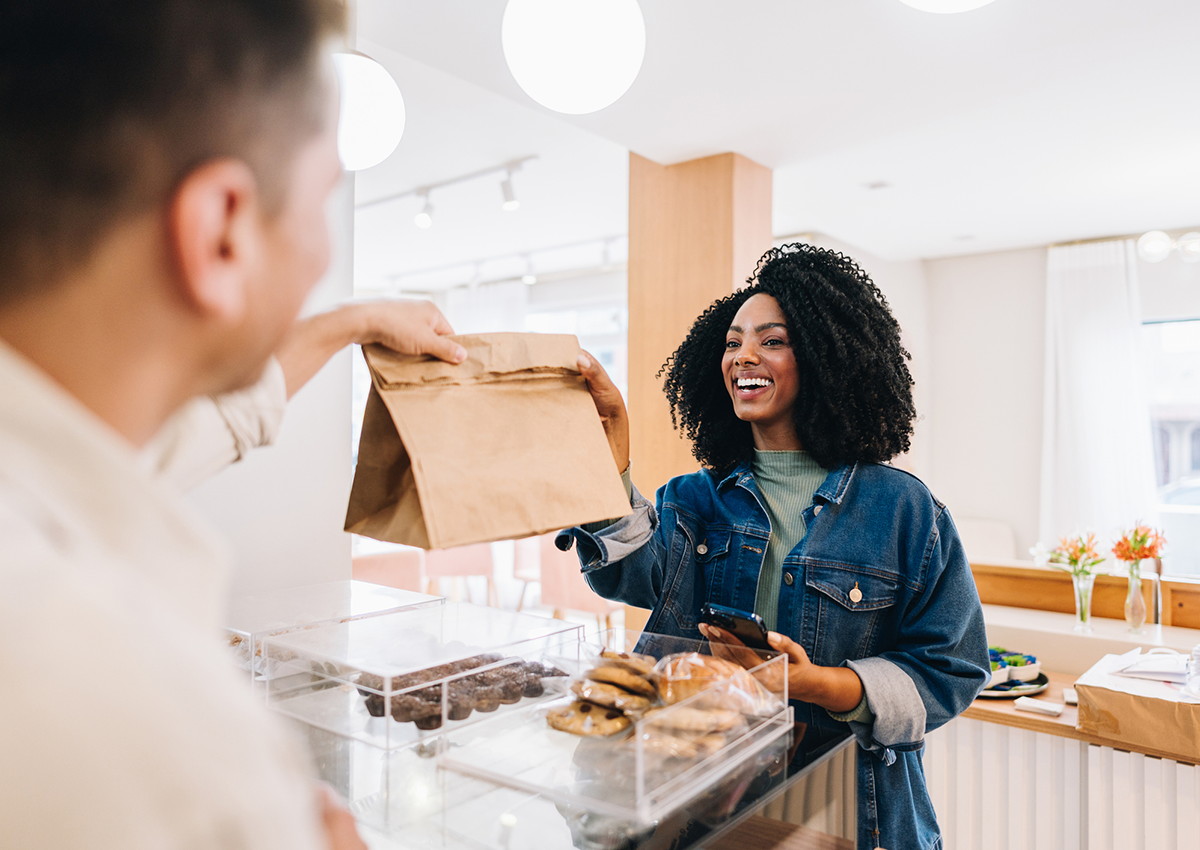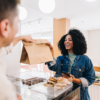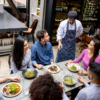Today, online ordering has become the norm in the restaurant industry. Whether consumers prefer takeout or delivery, the effect is the same: off-premise dining is booming, and online ordering is the standard.
The rise in online ordering started over the last five years, but in 2020, we saw the certainty of how important it was. Many restaurants quickly adopted online ordering to keep their business afloat and cater to their customers’ needs.
Mobile and online ordering have skyrocketed across all industries because of their convenience. Online ordering solutions allow you to serve your guests more efficiently, add an additional revenue stream, and boost your online presence.
Does your restaurant offer online ordering? Check out the top 28 must-know stats that prove how powerful online ordering is.
Restaurant Online Ordering Statistics
Here is a list of statistics to show you how fast online ordering is growing, what it can do for your business, and how consumers prefer to order.
- About 94% of diners say online reviews significantly influence their dining selections.
- The revenue in the Online Food Delivery market is forecasted to reach U.S. $1.22tn in 2024.
- Online food delivery revenue is expected to show an annual growth rate of 8.29%, resulting in a projected market volume of U.S. $466,472 million by 2026.
- Restaurants with an online ordering system are able to raise their takeout profits by 30% higher than those who do not.
- Nearly 70% of consumers ordered delivery in the past month as of March 2024, according to DoorDash.
- With a market share of 67%, DoorDash dominated the online food delivery market in the U.S. as of March 2024. Meanwhile, Uber Eats has the second-highest share with 23%.
- Customer spending increases 20% when ordering via technology, according to Deloitte.
- Deloitte’s research found that online ordering grew check averages for quick service restaurants by 26% and fast casuals by 13%.
- The restaurant-to-consumer segment for online food ordering reached 760 million users, a 20% increase year-over-year.
- Around 59% of millennial restaurant orders are for takeout or delivery.
- Consumers who order pizza online spend an average of 18% more than orders placed over the phone.
- About 70% of customers prefer ordering food online and want it to be delivered.
- The number of users in the online food delivery industry is expected to reach 2,656 million by 2026.
- Customers who place an online order with a restaurant will visit that restaurant 67% more frequently than those who don’t.
- Around 31% of American consumers use third-party food delivery services at least twice a week.
- Nearly 59% of millennial restaurant orders are for takeout or delivery.
- Some 66% of adults say they’re more likely to order food than they did before the pandemic.
- More than 55% of all adults surveyed say purchasing takeout or delivery is the way to live.
- About 37% of customers believe ordering via food delivery apps is the most reliable.
- With 60% of U.S. consumers opting for delivery or takeout at least once a week, guests continue to prove how much they love the convenience of online ordering.
- The online food delivery market is booming and is projected to keep growing, increasing from $3.7 billion in 2023 to $90.3 billion by 2030.
- Customers who order directly from the restaurant spend 35% more per transaction compared to those using third-party apps. To boost direct orders, consider offering promotions to these customers.
- Gen Z significantly influences online food delivery trends, with 69% of them opting for delivery, surpassing any other generation.
- Schedule your email promotions to go out around 6 p.m., as it’s a prime time for food deliveries.
- In 2023, online ordering accounted for 27% of all orders, encompassing both restaurant and convenience store transactions.
- By 2027, experts forecast that 2.5 billion people globally will be using food delivery services.
- In 2023, 13% of customers favored using third-party apps or websites, whereas 40% preferred ordering directly through the restaurant’s website.
- Customers who opt for delivery typically spend 20% more compared to those who pick up their orders.
How to Create a Seamless Ordering Experience
The restaurant industry has faced substantial challenges over the past few years. A contributing factor to these difficulties is that some restaurants are not keeping up with consumers’ demand for technology. Offering a contactless experience and including online ordering is a crucial investment restaurant operators must consider adding.
The demand for technology will keep growing because of its speed in the ordering process, which makes customers happy. Restaurant owners and operators will look to keep expanding their online ordering software and other off-premise digital technology to gain customer satisfaction.
However, there is a disconnect between consumers and operators, and to stay competitive, you must begin to adapt to off-premise offerings.
Below are three tips on how to expand your off-premise dining and create a seamless ordering experience for your customers:
1. Get a directly integrated online ordering system
As a restaurant owner, you need a system that simplifies your operations and saves you money. Indeed it’s easy to turn to third-party ordering and delivery platforms because of the instant online customer base they offer. But, you could lose an average of 25-30% of monthly revenue with these providers.
To have complete control of your online ordering, you need an integrated system that works with you, not against you. When restaurants offer online ordering through their POS system, like CAKE’s Online Ordering, they get these benefits below:
- Increased revenue.
- Increased order accuracy.
- Saving time and money.
- Boost online presence.
2. Offer curbside pickup
The demand for curbside pickup has tremendously increased since the pandemic. For many restaurants, that was the only way of staying in business. Soon after, customers began to favor this alternative way of dining.
Curbside offers the convenience and safety that guests want when ordering food online. Make sure that guests have the option to pick up curbside within your online ordering system to ensure this.
You want to make this process as seamless as possible for you and your guests. Get a system that allows for two-way direct communication through text so you can identify customers hassle-free and with minimal contact.
3. Create a custom ordering experience
To attract more customers to your site directly, you need to tailor your online ordering to be custom to your brand and easy to navigate. You can do this by completing a menu analysis. From the content itself to the overall feel of the menu, creating the right aesthetic is essential to draw the customer’s attention.
You need an online ordering system that acts as an extension of your brand so guests feel like they are getting the same kind of service from you online that they would in person. Consider these five things when evaluating your menu online ordering system:
- Do you have the ability to personalize your platform with your logo, branding, and images of your food?
- Are guests easily able to make modifications to their orders?
- Does your system accept multiple payment options so guests can pay how they’d like? (Credit cars, Apple Pay, or Google Pay)
- Is the platform easy to navigate, and can it integrate with your website?
- Does it have the ability to offer different pick-up options, such as curbside pickup or contactless delivery?
When you have a direct restaurant online ordering system, you have the power to create a custom ordering experience that will benefit your business and customers. Additionally, it will help strengthen your brand recognition an online visibility. An in-house online ordering system just makes sense.
Based on the statistics you’ve seen, online ordering is here to stay and is only going to continue to thrive. It offers convenience for your customers, ultimately enhancing the ordering experience.
FAQs
How do restaurants handle fluctuations in demand for online ordering during peak hours or special occasions?
Restaurants typically handle fluctuations in demand for online ordering during peak hours or special occasions by implementing strategies such as dynamic pricing, staffing adjustments, and optimizing kitchen workflows. Dynamic pricing allows restaurants to adjust menu prices based on demand, encouraging customers to order during off-peak hours. Staffing adjustments can involve scheduling more personnel during peak times to manage orders efficiently. Optimizing kitchen workflows involves streamlining processes to handle increased order volumes without sacrificing quality or speed of service.
What are the common challenges faced by restaurants when implementing and maintaining a directly integrated online ordering system?
Common challenges faced by restaurants when implementing and maintaining a directly integrated online ordering system include technical issues such as system downtime or glitches, integration complexities with existing POS systems, and the need for ongoing staff training and support. Ensuring seamless integration between the online ordering system and POS requires meticulous planning and coordination. Additionally, staff training is crucial to ensure smooth operations and minimize errors when processing online orders.
Are there any insights on how online ordering affects dine-in business and customer satisfaction in the long run?
Online ordering can help boost overall business for restaurants and increase customer satisfaction. Recent insights from Paytronix’s 2023 Online Ordering Report have found that guests using a restaurant’s integrated online ordering system return, tip, and spend more. In addition, brands that are respond to reviews can see a 23% in orders and 22% higher ratings from customers. Such research may explore changes in customer behavior, preferences, and spending patterns in response to the availability of online ordering options. Additionally, assessing customer satisfaction with online ordering compared to traditional dine-in experiences can provide valuable insights into the evolving landscape of restaurant operations and consumer preferences.







